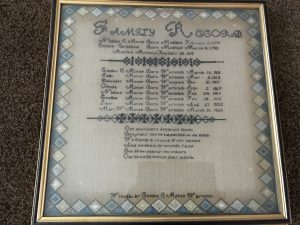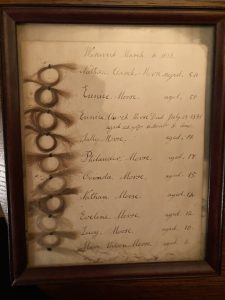
- Until I was a teenager, I thought a “Sampler” was a box of chocolates. Then my grandmother died and many of her items found their way to us in California. Included in this trove was a sampler — a framed textile and another framed object which I will describe below.
A “sampler”, loosely defined, is a piece of cloth into which is stitched, by needlepoint, a picture or some writing, or both. They have been around a long time. Shakespeare mentions one, and some exist from ancient Egypt. Samplers were very popular in colonial America until the end of the 19th Century. Indeed, I’m sure there are those who are stitching them as I write. In New England, girls were expected to make them. The oldest girl created a family record, stitching in the names of her parents, their birthplace and birthdates, and place and date of their wedding. Also listed are her siblings and their birthdates and places of birth. There is often an inspirational or philosophical poem as well.
The other girls also made samplers, but rather than a family record, they show various scenes, and often, for some reason, copies of the alphabet. (See the cover photograph of a book I own as the featured image.) Since (I suppose) the names of long-dead relatives are of interest primarily to their descendants, whereas bucolic or other scenes have universal appeal, collectors are less interested in a “family record” sampler.
The sampler I have is of the family record type: 
It lists the parents as Nathan Morse and Eunice Cleveland, both born in Medfield, Massachusetts in 1779 and 1783, followed by their eight children (born over a period of 15 years — five girls and three boys). It was “wrought” by daughter Eunice in Warwick, Massachusetts, and is accompanied by a poem reminding us of mortality and generations to come:
Our ancestors departed bloom
Bespeaks we’re hastening to the tomb
We’ll keep a record of our names
And meditate in worldly fame
But generations yet unborn
Our lives in virtue may adorn.
I am one of those in the fifth “generation yet unborn”.
There was a related bonus that arrived from my grandmother’s possessions — a framed handwritten list of all the names on the Sampler, with their ages at the time of its composition, and, remarkably, accompanied by a lock of hair from each family member.  I’m descended from Sally Morse, the second-born daughter. Initially, I wondered, why is it that my family has the sampler “wrought” by Eunice Morse, instead of her descendants? The answer is written next to and under her name: Died July 25, 1831 aged 20 years 2 months 8 days. I assume it is her sister Sally’s handwriting on this record.
I’m descended from Sally Morse, the second-born daughter. Initially, I wondered, why is it that my family has the sampler “wrought” by Eunice Morse, instead of her descendants? The answer is written next to and under her name: Died July 25, 1831 aged 20 years 2 months 8 days. I assume it is her sister Sally’s handwriting on this record.
What makes these special to me is more than something from a family of ancestors I otherwise would know very little about. It allows me to get a glimpse — very small, of course — of something important to this family, their hopes, and no doubt, tragedy — and their desires, reflected in the verse, to pass it on to me and my generation.



These very old objects are a true treasure, Mr. Ed. What a gift to have such a family history stitched centuries ago. The alphabet might be a form of showing off needlepoint and embroidery skills, which girls and young women of that time were expected to have. As someone who used to do needlepoint, I know firsthand that fine embroidery is really difficult to do. I was a pleasure to read your story.
Thank you for these very nice comments. It’s very gratifying to write something which strikes a chord. As for needlepoint, I admire your courage. I would never attempt it!
I agree with Marion, that the sampler was a “sample” of the woman/girl’s skill in needlework, with the bonus of being a piece of family history. The story that can be inferred from Sally’s note is tragic indeed. Childbirth would be the obvious cause of death, but who knows? It is a treasure. On a separate note, special indeed to have the locks of hair, could do DNA if needed. Wonder if from the forelock, mane or tail.
Thanks, Khati — doing a DNA/ancestry search could be illuminating. I worry about privacy concerns, although it’s probably a futile endeavor. Secondly, the possibility always exists that I have no genetic link to the Morses — do I want to know? One of the boys was named Philander — maybe it characterizes more of the family.
I’m thinking that because equine eyelashes are so long and lovely (I’ve hidden them in my photo) I should submit one of them. Might reveal some beautiful genes.
This is a lovely story of your family history Ed and you’re lucky to know so much.
I have some family memorabilia but just a little,, and sadly many family photo albums that were stored in the basement of our apartment building were destroyed years ago when Hurricane Sandy flooded that basement – irreplaceable!
I worry about hurricane Sandy events as well. Ours could be an urban fire leading to similar destruction. I am hopeful and grateful that Retrospect is a hedge against that type of loss. So far, I’m very lucky with the family history info and artifacts.
Khati’s wit has not slowed in lo these many decades, Mr. Ed. Horses have to prance quickly to keep up with her!
I felt very privileged in getting to have access to such a lovely and personal artifact, the likes of which I have never known nor heard about.
Thanks, Dale. I owe the access to this info, of course, to people long dead. Glad you enjoyed the story and the comments it inspired.
Lol to Khati’s comment! The genealogy types would say you should do ancestry.com and find out about additional relatives you might have. Maybe even other descendants of Sally Morse.
Ed, this is fantastic! What a treasure to a have something from your ancestors giving family history dating back so long (and, as Khati noted, a bit of DNA as well). Yes, women’s work was to do that fine stitching (don’t countless movies depict women engaged in such work; I have one cousin who does cross-stitching – I can’t even imagine such a thing).
When I took you on the slow driving tour of downtown Edgartown, one of the streets where we seriously considered buying a house (and the Marina was located) was Morse Street. I wonder if there’s a connection, given that you are also related to the Nevins and there are streets named for them too. A storied history.
Yes, the slow driving tour of Edgartown was great fun. The Nevin connection is very recent, comparatively. I’ve always wondered if Samuel F.B. Morse is somewhere in the tree. I’ve often thought we’re related to everyone in Connecticut and Massachusetts given that that the roots on both of my mother’s lineage go back to the 17th century in both states. One of her early ancestors in Connecticut had 11 children. So lots of ancestors that can be traced, given the time and interest. I prefer to dabble.
Wow, Mr. Ed, that is quite an impressive treasure you possess. The locks of hair are amazing, as is your ability to trace your ancestry back so far.
Thanks, Laurie. I’ve always been amazed by the locks of hair. One of our friends thought that they were a bit ghoulish. They had never seen the carvings on early 19th century tombstones. Tastes change, of course.
One of the greatest ledes I’ve ever read, Mr. Ed, truly great.
Thank you for displaying your wonderful family lore, especially the locks of hair — looks like you have some palominos in your line. I can add nothing to the above deserved comments, so I’ll go back to my cross stitch now.
Thank you for the high praise! And yes, palominos figure prominently.